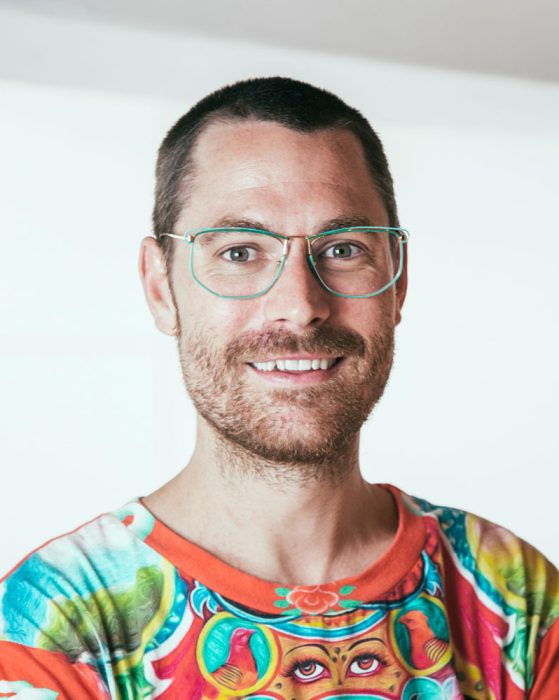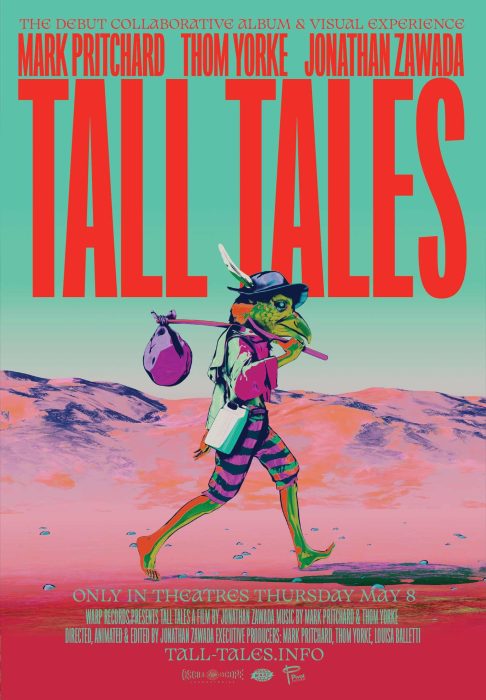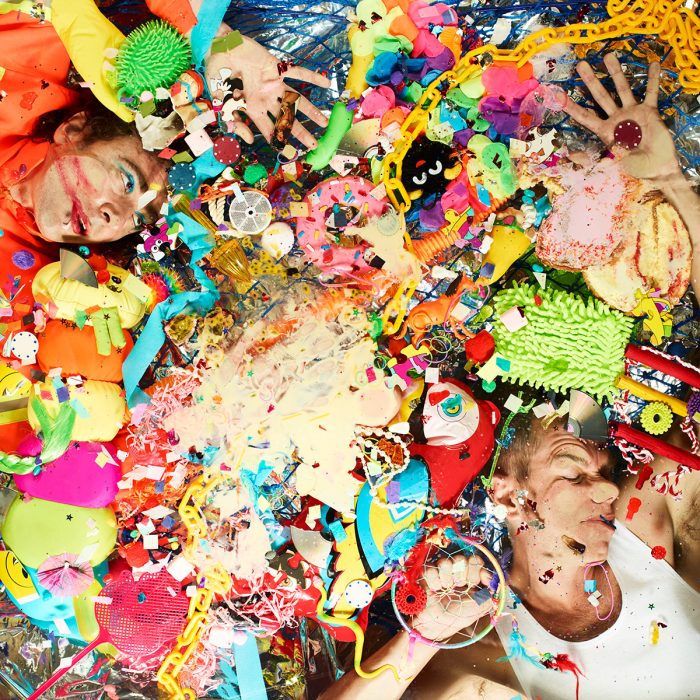
Zawada, Smiling at the Camera
Australian artist Jonathan Zawada is renowned for multi-disciplinary work exploring technology’s complex interplay with human experience across painting, video, and installation. With roots in web design and coding, his practice seamlessly blends the artificial and natural in striking hyperreal visuals. Known for extensive collaborations with music artists like Flume, Mark Pritchard, and Thom Yorke, whose projects garnered ARIA recognition, Zawada exhibits internationally. His conceptually driven aesthetic, seen across fine art and commercial realms, acts as a compelling lens into the networks shaping contemporary existence, mirroring our intertwined realities.
Pt 2 drops May 8–Tall Tales premieres worldwide. Save the date!

Tall Tales‘ Premiere Poster
Miro, Mycelium, & Music
- Tall Tales spans multiple episodes and mediums. What was the initial spark or core concept that ignited this project?
- Did Tall Tales emerge from a meticulously planned framework, or did it evolve organically through visual experimentation?
- How did you structure the workflow for such a multi-layered project, balancing episodic storytelling, visual art, and musical components?
–
Mark Pritchard and I have worked together and been friends for something like 10 or 15 years now and he always shares the music he’s making with me so quite early on I was listening to the demos of the songs as they were taking shape. On hearing the initial batch of songs even in their demo form, it was obvious to me that the album was something incredibly special and that I wanted to make something for it. All of the songs had such unique and strong identities that it seemed obvious from the start that they each needed to be addressed visually in some way.
–
Tall Tales was absolutely the result of organic evolution. For a very long time it wasn’t even especially clear that it would ultimately take the form of a film and for a large part of the process the ideas felt to me like they could work just as well as art installations as anything else. Gradually they came together as video pieces and then we approached the idea of pulling all of the videos together as a singular film. The project took over 4 years to complete and I worked on the videos often in tandem with the evolution of the songs so there was a lot of opportunity to try things out, experiment, throw things away, shuffle things around and start again.
–
I’ve become very reliant on online shared whiteboards. In particular I use Miro for almost everything I do and I can’t imagine tackling a project like this without it. Mark, Thom and I are all in different places in the world – we’ve only all been together in real life once when the whole thing was completed – so having a place where the whole project could live with all of its iterations, notes, thoughts and random ideas and comments was absolutely vital. The board we share serves as a way to share ideas, notes, inspirations and thoughts as well as organising structures and sharing work in progress, figuring out sequences etc visually without having to do a whole lot of speaking which is always nice.

Zawada’s MIRO-drive website
The ‘Tall Tales’ Tightrope
- What role did spontaneity and improvisation play in the development of individual episodes or pieces within Tall Tales?
- How does your approach to creative decision-making differ when working solo versus in collaboration with musicians like Mark Pritchard and Thom Yorke?
- With its layered nature, how do you determine when a piece or episode of Tall Tales has reached its definitive state of completion?
–
I think my process can be quite spontaneous in a way. I tend not to have very concrete storyboards or planned out sequences in mind before I start working on things, rather I like to get the concept in place and just start working on it so that I still have space to see where the process leads me and allow it to pull me in the direction that it wants to go. There were whole videos that we shot on film which got abandoned and videos that got completely reworked and swapped with different songs as the project evolved and we started getting a more concrete sense of where it was heading. Having the autonomy and the time to do that, working with just the three of us was kind of integral to that kind of process being possible.
–
When working on music collaborations there has inherently already been a fair amount of creative decision making that has taken place before I enter the picture. Feelings, moods and even the lyrics form a scaffolding from which I can explore different ideas but which I can never completely ignore. When I’m working on my own projects I can change any part of it at any point but with these kinds of collaborations I always have the music to come back to and to interrogate my work against. In a lot of ways this is hugely helpful and inspiring as it both creates interesting challenges and also a benchmark for the work to meet.
–
The finish line was unbelievably fuzzy on Tall Tales! Several videos were “completed” only to be revisited and reworked in both minor and major ways months or even years later. Having made everything myself it meant I never felt beholden to anyone which was very liberating. The real challenge there is holding onto the essence of what the project was over such a long time, allowing new thoughts and ideas in but not falling victim to the temptation to constantly change everything to the point that the core was no longer there. Having Mark and Thom to send things to and get responses from was probably one of the only ways I had of finding out when something was done as we could discuss what things didn’t feel right or areas where changes could be made and talk through the pluses and minuses of that. Its not dissimilar from making music so its good to be able to have that shared language of criticism when it comes to the work.
Instinct vs. Algorithm: Why Zawada’s Color Chaos Defies AI Art Trends
- Tall Tales evokes a distinct atmosphere—dreamlike yet disorienting. How did you intentionally craft this specific emotional landscape?
- Your worlds feel fantastical yet possess a sense of familiarity. What techniques do you employ to ground surreal elements and make them resonate?
- The color palettes in Tall Tales are often striking. How do you strategically use color to guide the viewer’s emotional and narrative experience?
–
I’m so glad it feels that way! I think a lot of that feeling was in the music and I just wanted to tease it out in the film. Disorienting is exactly the feeling I was hoping for but maybe not the thing I was consciously ever aiming for. I think having the freedom to explore a wide variety of approaches and mediums contributes a lot to that sensation, the ground is constantly shifting under you. By using techniques and visual language that is quite broad and spans a large time period you kind of get thrown in different directions and never feel stable. It’s definitely a tricky line to tread though, I was never quite sure if it was too chaotic or confusing but ultimately I felt like I’d never know where the line was if I didn’t try to push it.
–
I think there is something important in having material be personal and familiar – especially when it is surreal. We live in a strange world where anything you can think of you can manifest visually within seconds with AI so having a specificity in the choices made in the details of a work is really important. Really, almost everything that appears in Tall Tales has an important conceptual basis to why its there, nothing is just put in for the sake of being weird. I did so much research in so many different directions, exploring all sorts of stories from history, politics, economics that weave together and connect in various ways. I think those things are maybe the elements that help it feel grounded – at the very least they’re the things that help give me confidence in the ideas.
–
Overall my approach to colour is very much instinctual rather than strategic. In my life I like a lot of colour and I’ve never been scared of using it in my work. To me the music is so rich that a full palette of colour often felt appropriate but I can appreciate that that isn’t always what everyone else hears. I think knowing that I had the confidence of both Mark and Thom to do whatever I felt worked best, and that Mark has always responded positively to adventurous use of colour I felt like I had license to lean into that part of me. I had to be quite careful with it though as it need to be balanced throughout the project as a whole but in thinking of the whole album as a kind of tonal map of colours I think it helps create an overall emotional rise and fall that is needed for it to come together as a whole.

The Presets Artwork
Artist’s ‘Bottom-Up’ Recipe for Multi-Format Madness
- Recurring visuals like crystalline structures and distorted flora appear in your work. Do these emerge organically, or are they consciously employed as symbolic language?
- How do you approach translating the core aesthetic and tone of Tall Tales when adapting it for different formats like static art, animation, or interactive media?
–
I’ve always been a lot more comfortable away from people than amongst them and I think I’ve been drawn to natural forms over the course of my career for a variety of reasons. There’s something wonderful about all of the different levels that you can appreciate something like a flower from while at the same time it retains being simply a viscerally beautiful thing that you “feel” rather than intellectually interrogate. For me, a lot of these things transcend being reduced to cultural symbols – although of course they can be – which has always appealed me as a way of reaching a broad audience, one that you don’t need to presuppose any prior knowledge from.
–
Because the work grows from the bottom up, from a conceptual basis, rather than being a top down process of adapting assets to different formats I find the challenge is more picking which of many possible options is the one to go with. Over decades of doing this kind of work I’ve learned that it pays off in the long run to have a larger universe to be able to draw from and start my projects with that kind of a mindset, as opposed to becoming too stuck on a singular image that then has to be adapted and expanded out from. I’ve often thought of each project as being its own world that I get to live in and explore for a while and I don’t ever seem to find the edges which makes the process continually inspiring and rewarding.
How One Artist Hacked 8 Minutes of CGI on a Home Rig
- What key software or tools were essential in bringing Tall Tales’ animations to life? Did you develop any unique workflows for this project?
- How do you select which elements from your detailed still images to animate, and what considerations guide your choices in adding dynamism?
- What was the most significant technical hurdle you faced during the production of Tall Tales, and how did you overcome it?
–
I’ve never worked in a team or studio or even ever with any collaborators doing animation so I’m not sure what a normal workflow looks like. My process tends to be pretty messy and loose, which is always fun at the beginning and only becomes a problem further down the line as things start getting more complicated. Almost all of the animation was done in Blender with a little bit of Unreal Engine and some selected generative AI with local installs of various Stable Diffusion models and a wonderful piece of software called Visions Of Chaos. Some of the major developments for me were probably things like the custom psychedelic surface shaders for videos like Buggin Out and adapting some videos to Blender’s semi-realtime renderer Eevee in order to bring the render times down on some of the longer videos. I really enjoy messing around with nodes and procedural stuff so working on the Eevee shaders for Buggin Out was particularly fun, although they completely overhauled the Eevee renderer half way through the development of the project which threw something of a spanner in the works!
–
The primary motivator for most decision making is the music but deciding where to go with it and where to push against it can be tricky to figure out. There are videos like the one for Stags Heads which just felt so contemplative and meditative and where I wanted to give extra space to allow for people to focus on the vocal and so I treated the scenes almost like paintings with only very slight amounts of motion. Then there are moments, like the break in Fake In A Faker’s World where I realised after making the video that it needed to shift gears and so I introduced this kind of totally chaotic tumbling camera moment to disrupt the rhythm that had settled in up until that point. Those sorts of decisions really are almost totally instinctive and musical.
–
I think the major technical challenge was one of the sheer scale of the production and that I was taking it on entirely myself. Rendering 8 minutes of CG can be pretty compute-intensive so figuring out how to balance things out and design the production method to ensure I’d be able to actually render it all on my machine in my studio was imperative. I think the main solution there was simply one of having time. I was lucky to have been able to start on the project so early in it’s development, having a tight deadline is really the only thing that holds most things back as that introduces all sorts of other constraints around budget and starts limiting the decisions you can make, being somewhat free of that I was able to spread things out so that I could achieve most of what I wanted to.
Tall Tales’ Psychedelic Code: A trippy tech-poetry
- Did you actively explore any new or emerging technologies (like AI or VR) during the creation of Tall Tales, and what was the impact on the final work?
- Can you point to a specific instance in Tall Tales where animation conveyed a crucial narrative element that a static image alone could not achieve?
–
I had already been using generative AI before starting on Tall Tales in projects like videos for The Avalanches and Royksopp and it was naturally becoming part of my ideation and experimentation process. The interesting aspect to Tall Tales is how much the capability of AI and AI video evolved from the start to the finish of the project, going from a weird little thing that you couldn’t really produce anything final with to the kind of super realistic, temporally stable video generation that we have now. My approach to AI has always been largely one of treating it like one tool of many and where I’ve used it in Tall Tales it has been as a single layer amongst other processes. Interestingly one of the strongest and earliest conceptual basis for the work revolved around ideas of forgery and how we allocate value to art and while the place of AI in that discussion was present in my mind at the start its relevance increased to a degree I wouldn’t have predicted. There is a world where this whole project could have been just Blender animation, or just archival footage, or just AI but it’s the mixture of all of the different approaches that really speaks to the feelings of disorientation and complexity which are at the heart of the work.
–
There is a song called Wandering Genie, which is the second last song in the film which consists solely of a layered descending vocal line which says “I am falling” and the video is a never ending zooming motion piece, made with an odd Stable Diffusion motion model where everything is constantly in motion and it feels like you are both falling and flying at the same time. I can’t imagine how an appropriate accompaniment to this song could have been made any other way – I actually tried so hard to think of an alternative. When Thom saw it he said “that’s mad, that’s exactly what I see when I hear the song”. In that instance I think its only animation that can achieve the effect of everything shifting all of the time which is emotionally at the heart of the music.

Fisherian Runaway, An Open-Ended Project Exploring Generative Biological Forms
*Get much more info and inspiration from this delightful interview in Pt 2 <<










